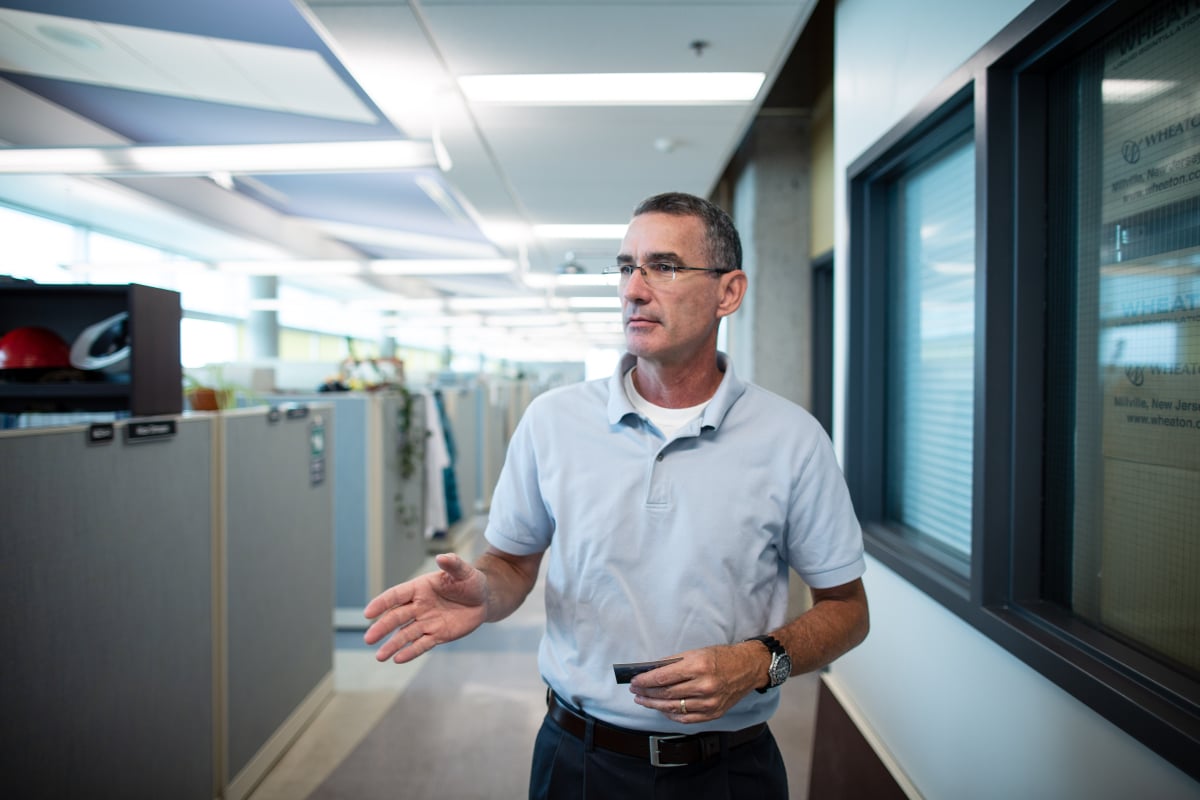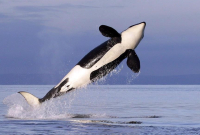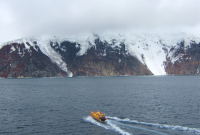Support strong Canadian climate journalism for 2025
Alice Ortmann emerged from a laboratory holding a large vial of black goop.
“It’s just come out of the refrigerator,” she said, holding it up to the light.
Ortmann is a Canadian federal government research scientist who looks at how microbes interact with oil and gas.
It was Sept. 18 inside one of the laboratories of Canada’s largest ocean research centre, the Bedford Institute of Oceanography near Halifax.
“So that would be, Access Western Blend,” chimed in Thomas King, another research scientist and Ortmann’s colleague, pointing at the vial.
That blend is a type of diluted bitumen, or dilbit — a toxic mix of the thick, tar-like raw crude oil called bitumen from Alberta’s oilsands, and the substances used to dilute it so it can be loosened up and transported through pipelines. Dilbit has been described by other scientists as a closely-guarded industry secret.

‘Is it going to stay on the surface?’
Ortmann and King's work at the institute is part of a research unit called the Centre for Offshore Oil, Gas and Energy Research, which has probably one of the best acronyms around: COOGER.
COOGER’s mission is to understand how oil spills behave. The group builds up a database of different test results checking how different types of oils behave in various conditions — rough versus calm water, fresh versus seawater, cold versus warm water.
At the institute, which is spread across a campus on the eastern shore of Halifax Harbour in Dartmouth, the team has access to outdoor tanks, as well as multiple labs for biological and chemical analysis of samples, and lab-based experiments.
“So if a major spill was to happen, what is that oil likely to do?” asked Rod Doane, a science liaison officer at COOGER.
“Is it going to stay on the surface, is it going to go down into the water, under a wide range of different conditions? And how effective are certain methods of treatment going to be on those spills?”

Trans Mountain’s risk
The team studies both the lighter types of crude oil, the kind that was spilled into the Gulf of Mexico in the 2010 BP deepwater drilling catastrophe, and the heavier bitumen that’s pulled out of the ground in Alberta.
Their work is of vital importance, as the Trudeau government pushes ahead with its plans to construct the Trans Mountain oil pipeline and tanker expansion project.
If completed, the project would triple the capacity of the existing pipeline system, allowing it to ship up to 890,000 barrels of petroleum products from Alberta’s oilpatch to a terminal in metro Vancouver.
Proponents say this is necessary to expand Canada’s access to new oil markets across the Pacific Ocean, helping to generate wealth and prosperity for Canadians.

But concerns have been raised for years about the risk that moving this amount of dilbit across land, and through the coastal waterways of British Columbia, would pose to the surrounding environment.
“Really heavy bitumen that is being produced in Alberta, and that might someday be piped to the west coast, well, what if something happens?” said Doane.
“If that was to spill somewhere in freshwater, or along the way, or if a tanker was to spill its load somewhere...what’s going to happen?”
The team at COOGER is compiling this information in order to give proper advice to those they refer to as “decision-makers” — the politicians, staffers, emergency responders and other officials who would be involved in the event of an oil spill. Some of them would have to make split-second decisions.
“We’re trying to get the information so we can at least predict what we think will happen,” said Ortmann. “We’ll at least have a good idea of what to expect.”

'Microbes really like to eat oil'
The longer it takes to respond to an oil spill, Ortmann explained, the more chance oil has to float on the surface of water and be exposed to sun and air, making it evaporate and thicken, a process the scientists call weathering.
In the lab, King held up another sample of bitumen that has been weathered outside in the test tanks. “You can see it’s almost back to a solid form,” he said. “It’s very solid.”
Many other factors come into play and make the situation more unpredictable. One example is the amount of sediment in the water. Ortmann said in the Gulf of Mexico, organic materials and sediment likely bound to the oil, making it sink to the ocean floor — even though the oil in the Gulf is a lighter oil.
But another thing that happened with Deepwater Horizon may prove useful for researchers like Ortmann. Scientists say microbes in the Gulf of Mexico ate a lot of the natural gas, which was mixed with the lighter oil that had spilled.
If Canada can figure out how to harness the work of these microbes, they might be able to use them as a natural oil spill cleanup.
“Microbes really like to eat oil,” said Ortmann. “We’re looking at how they can help clean up, how they naturally do it, and how we can potentially improve that.”
In one lab, scientists work in the dark, because phytoplankton will “bleach out” when exposed to harsh fluorescent light, explained Ortmann.

Get tanked
COOGER was formed in the early 2000s as one of many “Centres of Expertise” in the Department of Fisheries and Oceans (DFO). Its purpose was to jump-start a hub of oil spill research. There are about a dozen people working in the centre at any given moment, plus others from other departments working with them on things like sediment.
The institute is mostly staffed by scientists and other officials from DFO. They deal with everything from physical oceanography to whales and climate change.
There is also a fairly large group from Natural Resources Canada looking at things like marine geophysics and other staff from Environment and Climate Change Canada and the Department of National Defence. In all, more than 600 people work on campus, according to government figures. The campus sits next to a Canadian Coast Guard station.

The centre’s work studying bitumen spills isn’t exclusive. There are small labs doing this type of work elsewhere, said Doane, but the Bedford Institute allows for larger-scale analysis with seawater pulled directly from the ocean.
They carry out these larger studies with the help of outdoor wave tanks, which help scientists figure out how fast petroleum is broken down by microorganisms, which organisms are involved in that process, and how different conditions improve or inhibit that process.
The wave tanks are 100 feet long, two feet wide and roughly seven feet high — filled up with 30,000 litres of seawater, said King. They’re controlled by a computerized system that can generate different types of wave profiles.
The wave tanks can also generate create currents, which are used to flush the test seawater with clean water in order to see how it would be transported if there was an oil spill in the middle of the ocean.
There is also a smaller tank for long-term studies, where scientists add oil to different rings on a plastic disk, and then sample them from different points in time. A holding tank on the side also measures the effect of oil being released underwater — if there’s a deepwater drilling disaster, for example.
The outdoor infrastructure has grown and expanded from the early 2000s, typically runs from April until December, shutting down when the water is likely to freeze at night, which can break plastic pipes.

Four peaks
Back in the lab, King demonstrated some of the instrumentation to test viscosity. He showed how the lab can simulate a breaking wave effect by putting oil samples in flasks and letting them sit on a shaking machine.
The scientists can then add dispersants, a type of chemical that contains solvents that are used in oil spills to make oil spread out, and see how well they work with different types of wave strengths.
“In the wave tank, we do a lot of work with chemical dispersants, just to see how effective they might be,” said Doane.
“We’ll see differences — a certain type of oil might be more susceptible to dispersion in warm water versus cold water, but a certain type of dispersant might work better on another type of oil under those same conditions.”
BP used millions of gallons of a dispersant called Corexit in the Gulf of Mexico spill, to break the oil into tiny droplets. Industry says these dispersants are no more harmful than dish soap, but scientists said at the time there was not enough research done on them to say they were harmless.
There is an international stockpile of dispersant ready to go when oil spills happen, and current regulations in Canada say that if regulatory bodies in charge agree that using a dispersant would be beneficial, it’s allowed to be used, said Doane.

Other equipment COOGER uses includes concentrators — compressing large samples into small ones — as well as automated equipment to measure chemical components, like a gas chromatograph and a mass spectrometer, as well as sample storage containers.
A common way to analyze the components of a crude oil sample is to separate them according to polarity into four main classes, called saturates, aromatics, resins and asphaltenes.
King showed a machine that gives four “peaks” on a graph that correspond to those classes and vary in proportion. Lighter oils will show more saturates and aromatics, while heavier oils like bitumen — a non-conventional crude oil — will show more resins and asphaltenes.
“That becomes important in a spill," he said, because detecting those will show how the oil will behave when it breaks up.
Walking back from the outdoor wave tanks, National Observer asked Doane what he felt was important for Canadians to know about the team.
The centre has a “very rigorous program” trying to gather as much knowledge as possible about oil spills and methods of treatment, he said, “so that if something was to happen, a solid amount of information is available to use.”
“We are actively working all the time to gather as much information that can be used to minimize any damage that might occur,” said Doane.
“And to get that information to the people who make decisions,” chimed in Ortmann.
Editor's note: This story was updated at 7:40 p.m. EDT to clarify that a range of petroleum products is expected to flow through the Trans Mountain pipeline expansion.






Comments
So in the article we learned, among other things, that dilbit becomes denser over time. But what happens with the mass that is lost? The answer to that is not even hinted at. And, it doesn't take a rocket scientist to figure out that the mass is deposited in the environment as a pollutant. That stuff is poison. However, apparently that's not important enough to take notice of.
We also learned that microbes are really, really, good at eating up dilbit. (Well, actually, the denser stuff that remains after the more volatile chemicals get disbursed into the environment.) What products to the microbes produce after eating the tar stuff? What happens to the microbes when those wonder-microbes finish doing their superman thing? However, apparently the answers are not important enough to report.
Ah but that's the way our economic system works. Corporations are allowed to use our environment as a chemical dump in their profit making enterprises. Once they dump it, maybe some effete agency will give them a slap-on-the-wrist fine, or not. Or the people's taxes will be used to "research" what to do when the corporations dump for their profits; but the "research" will function as PR to assure the public that the corporations and their sock puppet politicians have it all under control.
The system is out of control and increasingly swamped by its failures. But the corporate profits continue to flow. I would have preferred some genuine analysis of this article rather than an encomium for those itty bitty microbes.
Actually, while the scientist said that microbes were "good at eating oil", the description of what happened in the Gulf of Mexico only said that microbes ate a lot of the natural gas mixed in with the oil, not the oil itself. So they might be "good at" it, but no evidence was mentioned that they actually DO it.
I've seen articles suggesting that on land, fungi--mushrooms and such--can be way better than bacteria at cleaning up petroleum on a sizable scale. But that's not so much use at sea.
It's a crime that massive expenditures are used on such research, rather than on promoting and supporting the alternatives to fossil fuel extraction!
And of course, the research totally misses the most salient point. Even if we were able to reduce (or even eliminate) the risk from spills into the ocean, the ongoing ‘intentional spills’ via expanded pipelines (into the global atmosphere) is still the greater risk to the planet.
Of course, in Science, as in life, it all depends on what question you choose to ask .Eg “Who benefits”? Follow the money.. It certainly isn’t going into job creation. The O and G Industry is de-manning in the oil fields as fast as possible. Do Albertans really believe they are benefitting from this Industry?